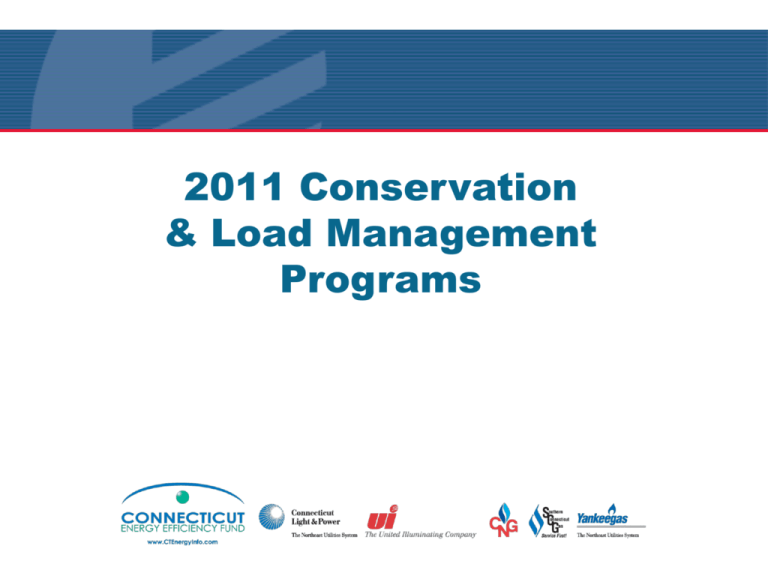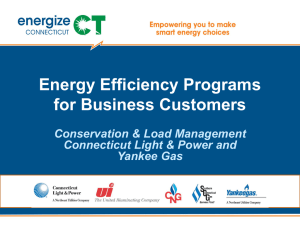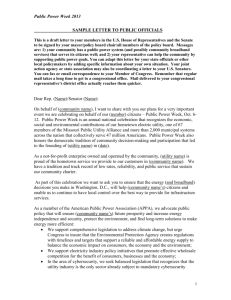Natural Gas Programs
advertisement

2011 Conservation & Load Management Programs Energy Efficiency & Background The overall vision for the future evolution of the CEEF C&I programs is to cost-effectively support a sustainable and competitive business climate for Connecticut’s businesses and industries based on bottom-line solutions for economic competitiveness, environmental stewardship, and social responsibility. Connecticut Energy Efficiency Fund (CEEF) was created in 1998 by CT State Legislature Energy efficiency is a valuable resource Reduces air pollutants and greenhouse gases Creates monetary savings for customers Reduces need for more energy generation Creates jobs CEEF Programs Offer technical assistance to commercial & industrial customers who want to improve energy efficiency Offer financial incentives to help implement energy-efficient measures No. 8 ranking in ACEEE’s 2010 State Scorecard Support economic growth in Connecticut* – Creates more than 2,675 direct jobs – Acts as an economic development engine creating businesses to deliver energy efficiency services *CT Renewable Energy / Energy Efficiency Economy Baseline Study - March 27, 2009 Program Administration Connecticut Department of Public Utility Control Energy Conservation Management Board Municipalities Bozrah Light & Power Groton Utilities Jewett City Dept. of Public Utilities Norwich Public Utilities South Norwalk Electric & Water Third Taxing District Wallingford Electric Electric Companies Connecticut Light & Power United Illuminating Natural Gas Companies Connecticut Natural Gas Southern Connecticut Gas Yankee Gas CEEF Fund Sources Funding is generated from electric and natural gas utility customers – Electric customers pay 3 mils per kilowatt-hour Funding is generated from natural gas utility customers – Natural gas programs are funded through gas utility bills and approved by the Department of Public Utility Control – Programs are for firm gas customers only 2011 C&I Program Budgets* Incentives CL&P $26,493,000 UI $ 6,482,278 YGS $ 2,149,672 CNG $ 1,512,321 SCG $ 1,331,253 % committed ~ 86% ~ 25% ~ 50% ~ 40% ~ 15% *Incentive budgets only Proposed – Pending DPUC Approval (Dockets 10-10-03 & 10-10-04) Includes CEEF, RGGI, ODR and ARRA Funds 2011 Project Incentive Caps $750,000 Cap (cumulative total all programs) per Federal Tax ID per year $150,000 Cap per metered site per program per year $100,000 Financing Cap per Municipality per project $400,000 Financing Cap per Municipality per year Gas Incentives ≥ $100,000 require DPUC approval The Incentive Cap does not apply to natural gas projects Commercial & Industrial Programs New Construction, Major Renovation & Equipment Replacement PRIME Retrofit Projects & Small Business Operations & Maintenance Projects Loans & Financing Retro Commissioning Load Management Energy Conscious Blueprint (ECB) Designed to capture electric and natural gas energy savings when they are most cost effective - during the design phase of new construction, major (gut) renovation or adding new equipment. Typically referred to as lost opportunities ECB - Custom – New Construction (Whole Building Performance) Designed to encourage integrated designs & high performance bldgs. Model Subsidy Base or “Code” Building Model High Performance Building Model $1000 $5000 Maximum Building /System Compliance (Installation) Whole Building Incentive (% better than code/$/sq ft) – – – – – – 10% 11% -15% 16% -20% 21% - 25% 26% - 29% > 30% $0.15/ sf $0.30/ sf $0.60/ sf $1.00/ sf $1.50/ sf $2.00/ sf Certification Bonus – LEED Silver / 2 Green Globes – LEED Gold / 3 Green Globes – LEED Platnium / 4 Green Globes $ 5,000 $10,000 $15,000 ECB - Prescriptive Lighting System Related Projects Lighting designs/installations ≥ 10% less than code – Incentives = lesser of $0.15/sq ft or $50/fixture Lighting designs/installations ≥ 30% less than code – Incentives = lesser of $0.50/sq feet or $50/fixture Occupancy Sensors $20/fixture controlled – Buildings over 5,000 sq. ft. must have lighting control strategy (as required by code) Subject To Utility Caps * Code = ASHRAE 90.1-2004 (all addenda) ECB - Prescriptive (continued) For non-lighting system related projects: We pay up to 95% of the incremental cost for new construction and up to 75% for equipment replacement We measure the incremental cost and the energy savings relative to Building Code* or reasonable & customary design practices Agreement is prepared and signed prior to ordering equipment & materials, or construction Subject to Utility Caps *Code = ASHRAE 90.1-2004 (all addenda) Specific Examples New construction High reflectivity roofing HE lighting, including w/occupancy sensors HE brine chillers HE heat pump loop system HE rooftop HVAC units Water-to-air heat wheels Variable frequency drives w/ HE motors on fans, pumps & kitchen hoods Oversized cooling towers CO2 control for air handling units Energy Opportunities (EO) Designed to improve the energy efficiency of customers’ existing facilities via retrofit opportunities. Retrofit: to voluntarily exchange or modify inefficient, functioning equipment with high-efficiency alternatives (for the sole purpose of saving $) EO (continued) Replace inefficient building systems Lighting system replacements & controls Heating & cooling system upgrades Process system upgrades Building control systems & repair Incentives designed to pay up to 50% of the retrofit cost for qualified projects EO (continued) For Lighting & non lighting system projects We can pay up to 40% of the installed cost of the energyefficient system change. – Up to 40% for qualified LED / Induction lighting technologies – Interior or exterior applications Lighting design must exceed Code by at least 15%. If not, use Express Lighting Rebate Application We measure the installed cost and the energy savings relative to what currently exists Agreement is prepared and signed prior to ordering equipment & materials Comprehensive Initiative A Comprehensive project is defined by the following criteria: Must have energy savings from at least two electric end uses and at least two measures – Gas measures within the project are not considered by the criteria One end use must equal 85 percent or less of the project’s energy savings or peak summer demand reduction value (based on $0.35 per annual kWh or $1000 per kW). The remaining end use(s) must equal 15 percent or more of the project’s energy savings or peak summer demand reduction value (based on $0.35 per annual kWh or $1000 per kW). * For more information, contact your Utility Representative. Comprehensive Incentives • Lesser of: – 50% installed cost (electric portion only) – Buy-down of project to 2–year payback based on customer electric metered savings – Energy savings caps based on the greater of $0.35 /annual kWh or $1000/summer peak kW combined Additional comprehensive incentives for firm gas projects: – 10% added to all qualifying gas measures Operations & Maintenance Improve electrical & gas efficiency of equipment through changes/repairs Not intended for normal preventive maintenance, repetitive procedures for a customer on a regular basis, or to subsidize major equipment purchases Typical Measures - EMS maintenance, i.e., replacement of defective sensors, relays and actuators, reprogramming - Compressed air system improvements (repair of leaks) Incentives - Up to 40% of installed costs Retro-Commissioning (RCx) Provides technical, engineering & implementation support to optimize the operation of your facility with out installing capital equipment Improve electrical and/or gas efficiency through changes or repairs Reset chiller discharge temperature Reset pump and fan speeds; Demand ventilation Optimization of AHU supply fan static pressure Broaden humidity set points in data centers Boiler optimization Confirm sequence of operations for EMS equipment Facilities must be ≥ 100,000 sq. ft. with Direct Digital Control system that can conduct trending & reporting - Incentives up to 100% for investigation fees (implementation required) Incentives up to 40% for the implementation costs PRIME (Process Reengineering for Increased Manufacturing Efficiency) Increase productivity and reduces per-unit energy usage through Lean Manufacturing Techniques and the Kaizen process Focuses on industrial manufacturing processes Typical benefits – Reduces waste of material, time and transportation – Reduces inventory requirements Using utility approved contractors, the first two events are provided at no cost to the customer. The customer shares 50% of the cost for up to two subsequent events Business Sustainability Challenge Utilizes a holistic approach to educating customers on the value of managing energy as a resource Makes energy and carbon management an integral and sustainable part of your business Provides businesses an opportunity to achieve long-term sustainability through: − energy management practices and investments − defined environmental/sustainable objectives − continuous improvement objectives Small Business Energy Advantage (SBEA) Retrofit program for C&I customers with ≤ 200 kW average billing demand Audits and installation provided by approved contractors 0% financing for qualifying customers Maximum loan amount - $100,000 On the Bill repayment available Maximum Loan Term – UI - 48 months – CL&P - 36 months SBEA Typical measures include: – – – – – – – Energy-efficient lighting, Lighting controls, Refrigeration equipment and controls, Compressed air systems, Variable speed drives, Energy management systems Programmable T-stats, etc. Incentives up to 40% of installed costs for eligible measures Eligible comprehensive projects can earn incentives up to 50% of the installed costs Subject to utility caps Loans & Financing 2011 SBEA & Municipal Financing – 0% Interest free loan with On Bill Repayment – $100,000 Maximum Loan (per qualified project) – Maximum Loan Terms • UI - 48 months; CL&P - 36 months – Customer size • up to 200 kW – Requires good bill payment history with utility – Utilities provide the funding source Loans & Financing 2011 Small C&I Energy Efficiency Loan – – – – Third-party lender and loan approval Subsidized low interest loan - ~7% Maximum Term = 5 yrs Loans between $2,000 and $250,000 with interest subsidies on the first $100,000 – Customer eligibility • in business for at least 3 years • avg 12 month demand greater than 10 kW up to 350 kW – Projects not eligible • Projects utilizing SBEA or Municipal Financing • Any new construction/major renovation projects Other Financing Opportunities Connecticut Hospital Association (CHA) Helps Connecticut hospitals finance major energy-efficiency projects. – Contact - Bob Sandler – (203) 294-7312 Department of Public Utility Control (DPUC) - offers loans to C&I customers for installing distributed generation equipment & energy efficiency projects that reduce system demand. 3rd Party - Bank of America One percent below Customer’s applicable rate or no more than the prime rate Minimum Loan Amount $1,000,000 – Contact - Courtney Guzman (Bank of America) • (617) 434-2888 • courtney.guzman@bankofamerica.com – Contact - Maureen Hoffman (DPUC) • (860) 827-2811 • maureen.hoffman@po.state.ct.us • DPUC Web Information: http://www.ct.gov/dpuc/cwp/view.asp?a=3356&q=419794 Tax Incentives Energy-efficient Commercial Buildings Tax Deduction (projects completed before Jan.1, 2014) Renewable-energy Tax Credits And Grants Qualifying Advanced Energy Project Investment Tax Credit – More Info: • • • • • www.efficientbuildings.org www.energytaxincentives.org/business www.dsireusa.org www.irs.gov/irb/2006-26_IRB/ar11.html www.treas.gov/recovery Tax Incentives Tax Deduction vs. Tax Credit A deduction is a cost subtracted from the adjusted gross income when calculating the taxable income; tax liability is not reduced dollar for dollar like a tax credit, but in proportion to the tax payer’s tax bracket Commercial Buildings Tax Deduction (all systems) capped at $1.80 per sq ft Commercial Buildings Tax Deduction (partial systems) capped at $.60 per sq ft Consult EPAct 2005 and IRS Notice 2006-52 for qualifications Courtesy of www.efficientbuilidngs.org and www.lightingtaxdeduction.org/tax_deduction.html Upcoming Training Events March – Energy Basics April – LEED, An Overview May – Building Performance Modeling: Equest (Interactive) May – O&M Best Practices June – Commissioning June – RetroCommissioning Check CL&P/UI Web Site Events Calendars For Updates/Registration Summary CEEF offers significant monetary assistance for energy efficiency – UI offers funding, financing and technical assistance CT is a national leader when it comes to implementing the Energy Efficiency programs Maximize the “Double Dip” − CEEF $$$; Federal Tax $$$ How Do You Get Involved? Pre-design / Design Phase Become aware of utility incentive programs Engage a utility representative throughout project Sign a Standard Agreement prior to proceeding with the project UI Contacts • UI Account Managers – Nick Cerjanec, Larry Mai, Tom Marella, Roger Parisi, John Albini, Barbara Pellicano, Gary Pattavina, Rick Valine, Chuck Winchell • Energy Engineers – Ken Bouchard, Mike Doucette, Mike Guarino, Dick Lombardo, Pat Reavy, John Sigona, Mike Stein • C&I Programs Roy W. Haller (203) 499-2025 • Residential Programs Chris Ehlert (203) 499-2965 • Natural Gas Programs Roy W. Haller (203) 499-2025 CL&P Contacts New Construction (ECB): Lomont White (860) 665-3790 Retrofit (EO): John Matchett (860) 665-3054 O&M/RCx: Dave McIntosh (203) 352-5457 Cool Choice/MotorUp Rebates: Dave Hayward (860) 665-3386 Express Lighting Rebates: Dave Hayward (860) 665-3386 Small Business: Randy Vagnini (860) 832-4753 Financing: Randy Vagnini (860) 832-4753 PRIME: Rich Asselin (860) 665-3292 Residential Programs: Joe Swift (860) 832-4936 Natural Gas Programs: Rich Asselin (860) 665-3292 CL&P Account Executives Web Information CEEF/DPUC www.CTEnergyInfo.com CL&P www.cl-p.com UI www.uinet.com Yankee Gas www.yankeegas.com CNG www.cngcorp.com SCG www.soconngas.com CCEF www.ctcleanenergy.com Questions? Michelle LeMoine, Marketing Representative Conservation & Load Management The United Illuminating Co. Office 203-499-5828 Michelle.LeMoine@uinet.com






